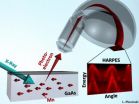(Press-News.org)
University of California, Davis, researchers for the first time have looked inside gallium manganese arsenide, a type of material known as a "dilute magnetic semiconductor" that could open up an entirely new class of faster, smaller devices based on an emerging field known as "spintronics."
Materials of this type might be used to read and write digital information not by using the electron's charge, as is the case with today's electronic devices, but by using its "spin."
Understanding the magnetic behavior of atoms is key to designing spintronics materials that could operate at room temperature, an essential property for applications.
The new study used a novel technique, hard X-ray angle-resolved photoemission spectroscopy or HARPES, developed by Charles Fadley, distinguished professor of physics at UC Davis and the Lawrence Berkeley National Lab, and recent UC Davis doctoral graduate Alexander Gray, together with colleagues at LBNL and in Germany and Japan.
The research represents the first major application of the HARPES technique, which was first described in a proof-of-principle paper by Gray, Fadley and colleagues last year.
The latest work was published Oct. 14 in the journal Nature Materials.
Angle-resolved photoemission spectroscopy uses Einstein's famous photoelectric effect to study materials. If you bombard atoms with light particles — photons — you knock out electrons, known as photoelectrons, which fly out at precise angles, energies and spins depending on the structure of the material.
For many years researchers have used "soft" or low-energy X-rays as the photon source, but the technique can look only at the top nanometer of a material — about five atoms deep. Fadley and Gray developed a method that uses "hard," high-energy X-rays to look much deeper inside a material, to a depth of about 40 to 50 atoms.
The researchers selected gallium manganese arsenide because of its potential in technology. Gallium arsenide is a widely used semiconductor. Add a few percent of manganese atoms to the mix, and in the right conditions — a temperature below 170 Kelvin (about 150 degrees below zero Fahrenheit), for one — it becomes ferromagnetic like iron, with all of the individual manganese atomic magnets lined up in the same direction. Physicists call this class of materials dilute magnetic semiconductors.
There were two competing ideas to explain how gallium manganese arsenide becomes magnetic at certain temperatures. The HARPES study shows that, in fact, both mechanisms contribute to the magnetic properties.
"We now have a better fundamental understanding of electronic interactions in dilute magnetic semiconductors that can suggest future materials," Fadley said. "HARPES should provide an important tool for characterizing these and many other materials in the future."
Gray and Fadley conducted the study at the SPring-8 synchrotron radiation facility, operated by the Japanese National Institute for Materials Sciences. New HARPES studies are now under way at LBNL's Advanced Light Source synchrotron.
INFORMATION:
Other authors on the paper are Jan Minár, Juergen Braun and Hubert Ebert, Ludwig Maximillian University, Munich, Germany; Shigenori Ueda, Yoshiyuki Yamashita and Keisuke Kobayashi, National Institute for Materials Science, Hyogo, Japan; Oscar Dubon and Peter Stone, LBNL and UC Berkeley; Jun Fujii and Giancarlo Panaccione, Istituto Officina dei Materiali, Trieste, Italy; Lukasz Plucinski and Claus Schneider, Peter Grünberg Institute, Jülich, Germany. Gray is now a postdoctoral researcher at the Stanford Institute for Materials and Energy Sciences, Stanford University, and the SLAC National Accelerator Laboratory in Menlo Park, Calif.
The work was supported by grants from the U.S. Department of Energy and the governments of Japan and Germany.
New finding could pave way to faster, smaller electronics
2012-10-24
ELSE PRESS RELEASES FROM THIS DATE:
New paper examines shifting gears in the circadian clock of the heart
2012-10-24
A new study conducted by a team of scientists led by Giles Duffield, assistant professor of biological sciences and a member of the Eck Institute for Global Health at the University of Notre Dame focuses on the circadian clock of the heart, and used cultured heart tissue. The results of the new study have implications for cardiovascular health, including daily changes in responses to stress and the effect of long-term rotational shift work.
Previous studies by a research group at the University of Geneva demonstrated a role for glucocorticoids in shifting the biological ...
Droplet response to electric voltage in solids exposed
2012-10-24
DURHAM, N.C. – For the first time, scientists have observed how droplets within solids deform and burst under high electric voltages.
This is important, the Duke University engineers who made the observations said, because it explains a major reason why such materials as insulation for electrical power lines eventually fail and cause blackouts. This observation not only helps scientists develop better insulation materials, but could also lead to such positive developments as "tunable" lenses for eyes.
As the voltage increases, water droplets, or air bubbles, within ...
Analysis of dinosaur bone cells confirms ancient protein preservation
2012-10-24
A team of researchers from North Carolina State University and the Palo Alto Research Center (PARC) has found more evidence for the preservation of ancient dinosaur proteins, including reactivity to antibodies that target specific proteins normally found in bone cells of vertebrates. These results further rule out sample contamination, and help solidify the case for preservation of cells – and possibly DNA – in ancient remains.
Dr. Mary Schweitzer, professor of marine, earth and atmospheric sciences with a joint appointment at the North Carolina Museum of Natural Sciences, ...
NJIT math professor calls Detroit Tigers a favorite to win World Series
2012-10-24
Since the Major League Baseball Division Series and League Championship Series have determined which teams will compete in the World Series, NJIT Math Professor Bruce Bukiet has again analyzed the probability of each team taking the title.
"The Detroit Tigers have a solid advantage over the San Francisco Giants. The Tigers, who surprisingly swept the New York Yankees in four straight games in the American League Championship Series to reach the World Series, have a 58 percent chance of beating the Giants in the best of seven series," he said.
At the season's start, ...
Medical recommendations should go beyond race, scholar says
2012-10-24
EAST LANSING, Mich. — Medical organizations that make race-based recommendations are misleading some patients about health risks while reinforcing harmful notions about race, argues a Michigan State University professor in a new paper published in the journal Preventive Medicine.
While some racial groups are on average more prone to certain diseases than the general population, they contain "islands" of lower risk that medical professionals should acknowledge, said Sean Valles, assistant professor in MSU's Lyman Briggs College and the Department of Philosophy.
For instance, ...
New Jersey's teen driver decals linked with fewer crashes
2012-10-24
A new study from The Children's Hospital of Philadelphia (CHOP) provides initial evidence that New Jersey's Graduated Driver Licensing (GDL) decal requirement lowers crash rates among intermediate (i.e., probationary) teen drivers and supports the ability of police to enforce GDL provisions. The study, which linked New Jersey's licensing and crash record databases to measure effects of the requirement, was published today in the American Journal of Preventive Medicine. Crash involvement of an estimated 1,624 intermediate drivers was prevented in the first year after the ...
Leaner Navy looking at future technology, fleet size and sequestration
2012-10-24
ARLINGTON, Va.—Adm. Mark Ferguson, vice chief of naval operations, headlined the opening of the ONR (Office of Naval Research) Naval S&T (science and technology) Partnership Conference and ASNE Expo Oct. 22, 2012, and highlighted the importance of innovative S&T programs being developed by the Navy. He also offered a revealing look at the potential future for the Navy if sequestration, or automatic defense cuts, goes into effect in January.
Speaking to a capacity crowd as keynote speaker, Ferguson said the Navy is already working hard to do more across the globe—with ...
Local wildlife is important in human diets
2012-10-24
Animals like antelope, frogs and rodents may be tricky to catch, but they provide protein in places where traditional livestock are scarce. According to the authors of a new paper in Animal Frontiers, meat from wild animals is increasingly important in central Africa.
"The elephant or hippopotamus may provide food for an entire community, smaller antelope may feed a family, while a rat or lizard may quell the hunger of an individual. Alternatively, these species are often sold on the road side or at local markets to supply a much needed source of cash revenue," write ...
Helping North America's marine protected areas adapt to a changing climate
2012-10-24
This press release is available in French and Spanish.Tampa, Florida, 23 October 2012—Top marine predators like tuna and sharks are suffering from the effects of climate change as the availability of prey decreases and the spatial distribution of their prey shifts. Countless other marine plants and animals are also affected.
One way to adapt to or mitigate these changes is to design marine protected areas (MPA) and MPA networks that integrate these and other climate-related considerations. Accordingly, the Commission for Environmental Cooperation (CEC) has published Scientific ...
Mercyhurst University study to identify levels of sucralose in Erie beach waters
2012-10-24
ERIE, Pa. - Researchers at Mercyhurst University continue to investigate the presence of potentially harmful chemicals in the beach waters of Presque Isle State Park and have added a new one to their list: sucralose. A chlorinated form of sucrose found in artificial sweeteners, sucralose is used in an estimated 4,500 products ranging from Halloween candies to diet sodas.
Studies suggest that approximately 95 percent of ingested sucralose is not metabolized by the body and is excreted into the water supply, said Dr. Amy Parente, assistant professor of chemistry and biochemistry ...



